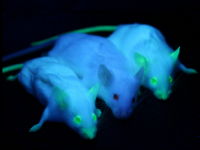








A genetically modified mouse is a mouse that has had its genome altered through the use of genetic engineering techniques. Genetically modified mice are commonly used for research or as animal models of human diseases.
Research
Genetics research often concentrates on identifying minute differences in the genome that give rise to assorted phenotypes. However, a large part of genetic control lies not in the makeup of particular genes or intergeneic regions but in their epigenetic conformation. The modification of DNA or of chromatin can profoundly affect gene expression without causing mutations. Rudolf Jaenisch, a member of the Whitehead Institute and Professor of Biology at Massachusetts Institute of Technology (Cambridge, MA), has made enormous contributions to the understanding of epigenetic mechanisms. Jaenisch created the first transgenic mice that enabled researchers to study epigenetic control of genomic viral DNA and advanced the epigenetics field through the studies of knockout mice and, most recently, cloned mice.
Uses
Genetically modified mice are used extensively in research as models of human disease.The most common type is the knockout mouse, where the activity of a single (or in some cases multiple) genes are removed. They have been used to study and model obesity, heart disease, diabetes, arthritis, substance abuse, anxiety, aging and Parkinson disease.Transgenic mice generated to carry cloned oncogenes and knockout mice lacking tumor suppressing genes have provided good models for human cancer. Hundreds of these oncomice have been developed covering a wide range of cancers affecting most organs of the body and they are being refined to become more representative of human cancer.The disease symptoms and potential drugs or treatments can be tested against these mouse models.
A mouse has been genetically engineered to have increased muscle growth and strength by overexpressing the insulin-like growth factor I (IGF-I) in differentiated muscle fibers.Another mouse has had a gene altered that is involved in glucose metabolism and runs faster, lives longer, is more sexually active and eats more without getting fat than the average mouse.
Great care should be taken when deciding how to use genetically modified mice in research.Even basic issues like choosing the correct "wild-type" control mouse to use for comparison are sometimes overlooked.